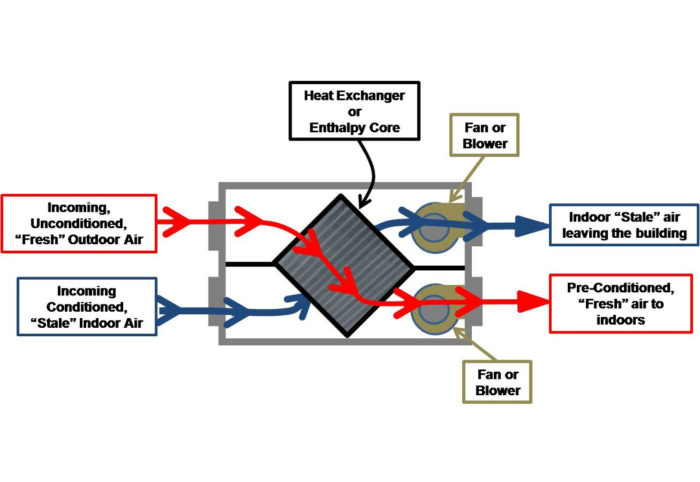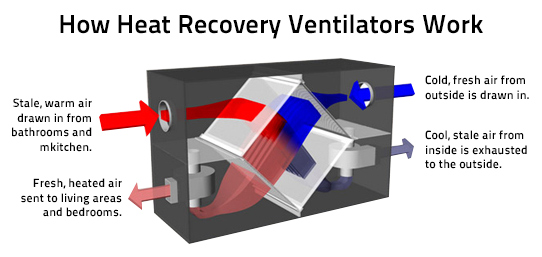Exactly How Heat Recovery Ventilation Improves Indoor Air High Quality and Reduces Power Costs
Heat Recovery Ventilation (HRV) systems play an important role in improving interior air high quality while at the same time reducing energy expenses. By efficiently exchanging stale interior air with fresh exterior air, HRVs help preserve ideal moisture and decrease toxins. In addition, their capability to recoup heat from outbound air lessens the strain on heating and cooling down systems. As power costs remain to rise, comprehending the complete potential of HRV systems ends up being increasingly vital for house owners and services alike.
Understanding Heat Recovery Ventilation Solutions

Heat recovery ventilation (HRV) systems play a crucial role in improving interior air top quality, particularly in modern-day, energy-efficient buildings. These systems are created to move heat from the outgoing stale air to the incoming fresh air, consequently decreasing energy loss while maintaining optimal temperature level degrees indoors. HRVs include a warm exchanger, fans, and ductwork, promoting the continuous circulation of air. By removing indoor contaminants and introducing fresh air, HRVs assist to balance moisture degrees, protect against mold growth, and decrease allergens. The effectiveness of HRV systems hinges on their capability to recoup as much as 80% of the warm from the tired air, promoting energy conservation while guaranteeing a healthy indoor environment. Their assimilation is essential in attaining lasting living methods.
The Value of Indoor Air High Quality
Indoor air quality (IAQ) is an essential factor influencing the health and wellness and wellness of owners in any kind of environment. Poor IAQ can lead to various health and wellness problems, including respiratory system problems, allergies, and tiredness. Furthermore, it can worsen status quo such as asthma. Elements adding to low IAQ consist of toxins from interior sources like cleansing agents, mold and mildew, and poor ventilation. Keeping great IAQ is essential for advertising a risk-free and comfy living or functioning space. Reliable methods to improve IAQ involve routine surveillance of air top quality, correct air flow systems, and decreasing using harmful materials inside your home. By focusing on IAQ, people can ensure a healthier atmosphere that cultivates efficiency and general top quality of life.
Energy Efficiency Advantages of HRV Systems
Lots of property owners and structure managers are progressively identifying the energy effectiveness advantages of warm healing air flow (HRV) systems. By transferring warmth from worn down indoor air to inbound fresh air, HRV systems considerably lower the power required for heating & cooling. This process decreases reliance on typical cooling and heating systems, resulting in reduced power expenses. Additionally, HRVs assist preserve a balanced indoor climate, preventing excessive home heating or cooling down needs. The ability to recuperate approximately 90% of the warmth from outgoing air also supports sustainability initiatives by decreasing overall power intake. Subsequently, HRV systems add not just to cost savings yet likewise to a minimized carbon footprint, aligning with the growing focus on energy-efficient building practices.
Installation and Upkeep Considerations
The reliable execution of warm recovery air flow (HRV) systems requires mindful consideration of installation and upkeep factors to assure peak performance. Correct positioning of the HRV system is important, as it ought to be mounted in a place that maximizes air flow while minimizing sound disruption. Furthermore, ductwork should be suitably sized and insulated to stop power loss. Routine maintenance, consisting of filter replacement and system cleaning, is vital to protect optimal performance and interior air top quality. Proprietors must establish a regular upkeep schedule to determine and deal with potential issues before they intensify. Collaboration with seasoned experts throughout both installment and upkeep phases can boost the durability and effectiveness of HRV systems, inevitably resulting in better indoor settings and reduced energy prices.
Real-World Applications and Success Stories
Discovering real-world applications of heat recovery ventilation (HRV) systems exposes their substantial influence on interior air quality and energy efficiency across different settings. In property buildings, home owners have actually reported Discover More better air quality, causing fewer allergies and respiratory system issues. Schools carrying out HRV systems have actually noted boosted student concentration and lowered absenteeism as a result of better ventilation. Business buildings, such as offices and retail areas, have actually experienced reduced energy costs and boosted staff member productivity. As an additional hints example, a company office in a temperate environment accomplished a 30% reduction in energy costs after mounting an HRV system. These success stories demonstrate that HRV technology not just adds to healthier environments but additionally supplies tangible economic advantages, making it an important investment for numerous industries.
Frequently Asked Inquiries
Can HRV Equipments Minimize Allergens in Indoor Air?
The performance of HRV systems in minimizing indoor irritants mainly hinges on their capability to filter and exchange air. HRV Heat Recovery Ventilation. By continuously changing stale air, these systems can substantially decrease irritant degrees throughout interior settings

Just How Does Humidity Affect HRV System Performance?
Moisture considerably influences HRV system performance; high degrees can cause condensation, minimizing efficiency, while reduced moisture may boost air exchange. Balancing humidity is crucial for excellent operation and maintaining indoor air high quality.
Are HRV Equipments Noisy Throughout Procedure?
HRV systems can generate differing sound levels throughout operation, depending upon their design and installment. Some units run quietly, while others might generate recognizable noise, specifically at higher air movement settings or when inadequately preserved.
What Is the Ordinary Life Expectancy of an HRV System?

Can HRV Systems Be Utilized in All Environments?
HRV systems can be used in various climates, but their performance may differ - HRV Heat why not look here Recovery Ventilation. In extreme temperature levels, adjustments or extra systems could be essential to assure suitable efficiency and convenience while keeping interior air high quality